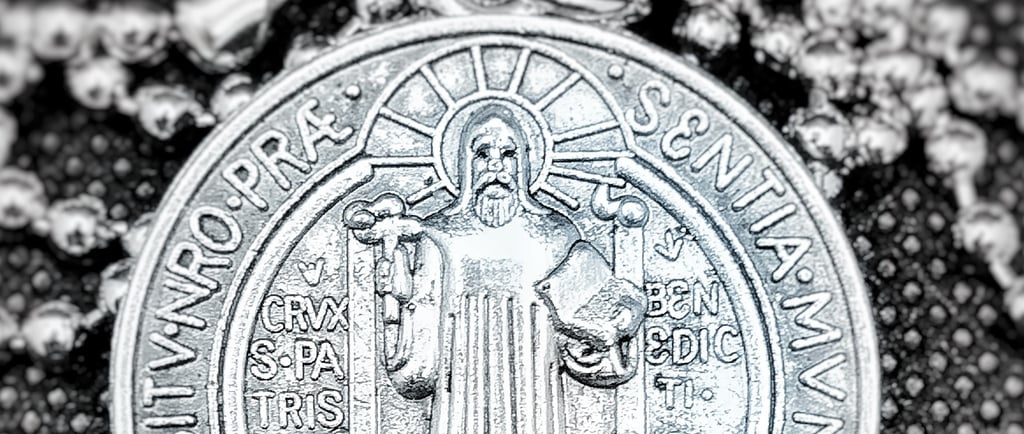Symbolism Behind the St Benedict Medal
The St Benedict Medal is one of the Church’s most treasured sacramentals, steeped in centuries of monastic devotion, spiritual discipline, and the triumph of the Cross over darkness. Its rich imagery and inscriptions invite the faithful into the heart of Benedictine spirituality, where prayer, work and communal life unite to resist evil.
FAITH DISCUSSIONS
Exploring the Symbolism and Meaning Behind the St Benedict Medal
The St Benedict Medal is one of the Church’s most treasured sacramentals, steeped in centuries of monastic devotion, spiritual discipline, and the triumph of the Cross over darkness. Its rich imagery and inscriptions invite the faithful into the heart of Benedictine spirituality, where prayer, work and communal life unite to resist evil. This small object has been present at pivotal moments in Church history, from medieval miracle stories to papal endorsements, embedding itself in the devotional life of countless believers.
Monastic Origins of the Medal
The roots of the St Benedict Medal trace back to the earliest days of Western monasticism. As early as the 11th century, Benedictine communities employed simple crosses and short Latin invocations on metal and parchment to invoke divine protection against both physical danger and spiritual oppression. These signs became standard elements of monastic life, reflecting the Rule of St Benedict’s call to “pray always” and to see every task as an act of worship.
Notable Historical Milestones
Early 11th century: Monks inscribe protective prayers and crosses on tokens, laying the groundwork for the modern medal.
1049 AD: Bruno of Egisheim-Dagsburg—future Pope Leo IX—nearly dies of a snakebite, then recovers miraculously after an apparition of St Benedict touching him with a radiant cross. As pope, he redesigns the cross into a medal attributed with blessings and indulgences.
1415: A forgotten manuscript discovered at Metten Abbey in Bavaria reveals the full prayers behind the medal’s mysterious initials, renewing interest in its exorcistic power.
1647: During a notorious witch trial at Natternberg near Metten Abbey, accused women admit they cannot harm the monastery protected by Benedictine crosses inscribed with the medal’s initials, sparking wider use as a defence against demonic attacks.
1741–1742: Pope Benedict XIV issues two briefs (23 December 1741 and 12 March 1742) solemnly approving and recommending the medal’s use to the faithful, attaching indulgences to its devout application.
1880: The Archabbey of Monte Cassino strikes the Jubilee Medal to celebrate the 1 400th anniversary of St Benedict’s birth, standardising the design still worn today and granting special Jubilee indulgences to those who carry it faithfully.
Pope Pius IX granted plenary indulgences to pilgrims who visited Monte Cassino with the Jubilee Medal, intertwining pilgrimage, monastic heritage, and sacramental grace.
Symbols and Inscriptions
Every element on the St Benedict Medal conveys a spiritual truth drawn from Benedictine lore and exorcistic prayer.
Obverse (Front):
St Benedict holding his Rule and a cross
Broken chalice symbolising the poisoned cup shattered by the Sign of the Cross
Raven bearing poisoned bread
Legend: Crux Sancti Patris Benedicti (“Cross of the Holy Father Benedict”)
Perimeter inscription: Eius in obitu nostro praesentia muniamur (“May his presence strengthen us at the hour of our death”)
Reverse (Back):
Central cross with initials C.S.S.M.L. – Crux Sacra Sit Mihi Lux (“May the Holy Cross be my light”)
N.D.S.M.D. – Non Draco Sit Mihi Dux (“Let not the dragon be my guide”)
Corners: C.S.P.B. – Crux Sancti Patris Benedicti
Border: V.R.S.N.S.M.V. – Vade Retro Satana; Numquam Suade Mihi Vana (“Begone, Satan; never tempt me with your vanities”) and S.M.Q.L.I.V.B. – Sunt Mala Quae Libas; Ipse Venena Bibas (“What you offer is evil; drink your own poison”)
Above the cross: PAX (“Peace”)
Spiritual Practices Associated with the Medal
As a sacramental, the St Benedict Medal prepares the faithful to receive grace and girds them for daily spiritual struggle. Worn on a chain, attached to rosary beads or displayed in homes and workplaces, it serves as a constant reminder of Christ’s victory over sin. Monks bore it through outbreaks of plague and waves of invasion; pilgrim families tuck it into satchels before long journeys.
The Medal as a Symbol of Exorcism
The Medal of St Benedict, often dubbed the “devil-chasing medal,” bears one of the Church’s most potent exorcistic formulas in abbreviated Latin. Its origins trace to a forgotten 1415 manuscript uncovered at Metten Abbey and to a 1647 witch-trial at Natternberg, where accused witches admitted they could not harm the monastery protected by these inscriptions. That trial revived the practice of inscribing the medal’s initials as a defence against diabolic forces.
Exorcists incorporate the medal directly into the Rituale Romanum. During formal deliverance rites, the priest may lay it upon afflicted persons, suspend it around doorways or altars, or even trace the Sign of the Cross with it in the air. In each case, the medal serves as a tangible invocation of Christ’s victory, its metal surface acting as a conduit for the Church’s solemn prayers of liberation.
At the heart of its power lie the initials on the cross arms: C.S.S.M.L. (Crux Sacra Sit Mihi Lux – “May the Holy Cross be my light”) and N.D.S.M.D. (Non Draco Sit Mihi Dux – “Let not the dragon be my guide”). Pronouncing or contemplating these words unfolds a concise renunciation of temptation, anchoring the wearer’s gaze on the Cross as the sole source of strength and illumination.
Encircling the cross are the letters V.R.S.N.S.M.V.; S.M.Q.L.I.V.B., an imperious command: Vade Retro Satana; Numquam Suade Mihi Vana; Sunt Mala Quae Libas; Ipse Venena Bibas (“Begone, Satan; never tempt me with your vanities; what you offer is evil; drink your own poison”). Adopted by exorcists since the 15th century and confirmed by Papal briefs in the 18th century, this formula confronts the tempter with Scripture-rooted authority, turning his own vanities back upon him.
Rome’s chief exorcist, Fr Gabriele Amorth, championed the medal’s use in nearly every deliverance he conducted. He observed that when combined with the sacramental life—Confession, Eucharist and prayer—the medal’s inscriptions magnified the efficacy of the rite, making it a staple in exorcists’ prayer kits and the Rituale Romanum’s appendix on spiritual warfare.
The Ancient Blessing Rite of the St Benedict Medal
The solemn blessing of the St Benedict Medal combines an exorcism, prayers of invocation and blessing, and the sprinkling with holy water. Drawn from the 1945 Roman Ritual and authorised by the Church’s Directory on Sacramentals (Can. 1168), this rite readies the medal as a conduit of grace and a bulwark against evil.
1. Invocation of Divine Aid
Priest and assembly call upon God before any exorcistic or blessing prayer is pronounced:
Latin
“V. Adjutorium nostrum in nomine Domini.Qui fecit cælum et terram.”
English
“V. Our help is in the name of the Lord.Who made heaven and earth.”
2. Exorcism of the Medal
With the Trinity invoked, the priest drives out every diabolic power that might taint the medal:
Latin Exorcism
“Exorcizo vos, numismata, per Deum Patrem omnipotentem, qui fecit cælum et terræm, mare et omnia, quae in eis sunt. Omnis virtus adversarii, omnis exercitus diaboli, et omnis incursus, omne phantasma Satanæ, eradicare et effugare ab his numismatibus; ut fiant omnibus, qui eis usuri sunt, salus mentis et corporis: in nomine Patris + omnipotentis, et Jesu + Christi Filii ejus, Domini nostri, et Spiritus + Sancti Paracliti, et in charitate eiusdem Domini nostri Jesu Christi, qui venturus est judicare vivos et mortuos, et saeculum per ignem.”Amen
English Translation
“In the name of God the Father + Almighty, who made heaven and earth, the seas and all that is in them, I exorcise this medal against the power and attacks of the evil one. May all who use this medal devoutly be blessed with health of soul and body. In the name of the Father + almighty, of the Son + Jesus Christ our Lord, and of the Holy + Spirit the Paraclete, and in the love of the same Lord Jesus Christ who will come on the last day to judge the living and the dead, and the world by fire.”
Amen
3. Liturgical Responses
Before the formal blessing, psalm-style responses turn the assembly’s heart to prayer and unity with the Church:
Latin
“V. Domine, exaudi orationem meam.Et clamor meus ad te veniat.
Dominus vobiscum.
Et cum spiritu tuo.”
English
“V. O Lord, hear my prayer.And let my cry come unto Thee.
The Lord be with you.
And with your spirit.”
4. Blessing Prayer
A comprehensive petition invokes God’s goodness through St Benedict’s intercession:
Latin
“Oremus.
Deus omnipotens, bonorum omnium largitor, supplices te rogamus, ut per intercessionem sancti Benedicti his sacris numismatibus tuam benedictionem + infundas, ut omnes qui ea gestaverint ac bonis operibus intenti fuerint, sanitatem mentis et corporis, gratiam sanctificationis, atque indulgentias concessas consequi mereantur, omnesque diaboli insidias et fraudes, per auxilium misericordiae tuae, devitare et in conspectu tuo sancti et immaculati valeant apparere. Per Christum Dominum nostrum.”Amen
English
“Let us pray.
Almighty God, the boundless source of all good things, we humbly ask that, through the intercession of St Benedict, you pour out your blessings + upon this medal. May those who use it devoutly and earnestly strive to perform good works be blessed by you with health of soul and body, the grace of holiness, and remission of temporal punishment due to sin. May they also, by your merciful love, resist every snare and deceit of the devil, and finally appear before you sinless and holy. This we ask through Christ our Lord.”
Amen
5. Sprinkling with Holy Water
The priest concludes by sprinkling the medals:
“Then the medals are sprinkled with holy water, sealing the blessing with the sign of purification and new life in Christ.”
This ancient rite—melding exorcism, prayerful invocation, blessing, and holy water—transforms a simple piece of metal into a sacramental: a tangible reminder of the Cross’s power, a shield in spiritual warfare, and a source of grace for all who wear it devoutly.
The St Benedict Medal remains a living link to our monastic heritage of prayer, work and spiritual combat. As we wear it or place it in our homes, may it draw us deeper into Benedictine wisdom: to seek peace in the Cross, to resist evil with prayer, and to live in humble obedience to God.
St Benedict Medal for Sale in
Our Store - Visit Now
Ancient Apostolic Catholic Church
Embracing faith, inclusion, and compassionate service together.
ST THOMAS AQUINAS SEMINARY
© 2025. All rights reserved
QUICK LINKS




